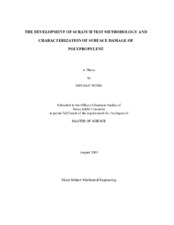| dc.description.abstract | A new scratch test methodology is proposed. The new test methodology is
developed based on the principles of materials science and solid mechanics, which
include the consideration of material parameters, use of microscopy for image
analysis and the finite element method (FEM). The consistency and reproducibility of
test results are shown using a new scratch test device on two sets of neat and talcfilled
polypropylene (PP) systems. Three different test conditions, i.e., linear load
increase under constant rate, constant load under constant rate, and linear rate increase
under constant load, have been conducted to determine the most effective, informative
test conditions for evaluation of scratch resistance of polymers. Experimental
observations and FEM results show a good qualitative correlation. The unique
advantages of the new scratch test method for evaluating scratch resistance of
polymers are discussed. A systematic study of surface damage effected by a
progressive scratching load is performed on model polypropylene (PP) systems. Mar-scratch
and stress -whitening transitions can be readily observed, and the
corresponding critical loads determined. Distinctive scratch hardnesses and surface damage features are
found for different material systems. Visibility of scratched surface is quantified
using gray level analysis via a flatbed scanner and a commercial image analysis tool.
It is found that the onset of scratch visibility can be determined accurately and
reproducibly using the custom -built scratcher under progressive loading condition.
Talc particles are found to be responsible for the increased light scattering, leading to
greatly increased visibility. The observed scratch visibility is also found to be related
to the measured frictional force profiles. Approaches for producing scratch
resistant PP are discussed. | en |


